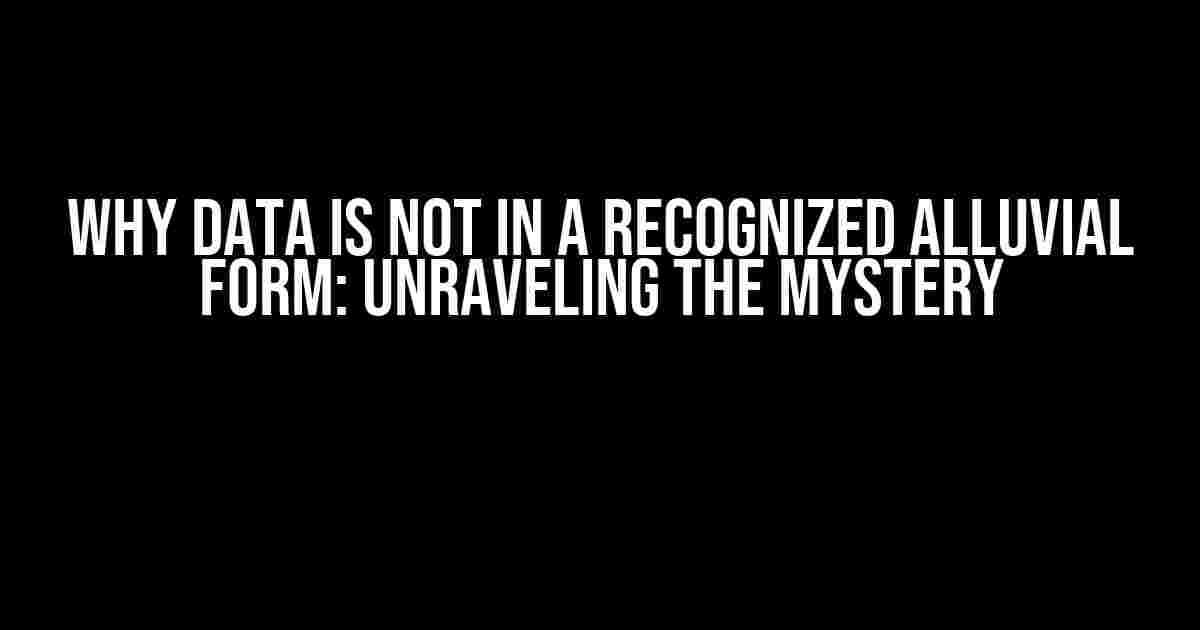Introduction
Data, in its various forms, has become an integral part of our digital lives. From simple spreadsheets to complex databases, data is everywhere. But have you ever stopped to think why data doesn’t conform to a recognized alluvial form? In this article, we’ll delve into the world of data and explore the reasons behind this phenomenon.
The Concept of Alluvial Forms
Alluvial forms refer to the deposition of sedimentary materials, such as sand, gravel, or silt, in a specific pattern. This process occurs naturally in rivers, deltas, and coastlines, resulting in distinct formations. But what does this have to do with data?
In the context of data, an alluvial form would imply a structured and organized pattern of data storage and retrieval. A recognized alluvial form would mean that data is stored in a standardized, hierarchical, and easily accessible manner. But, as we’ll see, this is often not the case.
The Nature of Data
Data, by its very nature, is complex and multifaceted. It can come in various formats, shapes, and sizes. From numerical values to text-based information, data can take many forms. This diversity makes it challenging to pinpoint a single, recognized alluvial form.
Moreover, data is often generated from diverse sources, such as social media, sensors, or user interactions. This heterogeneous nature of data makes it difficult to standardize storage and retrieval processes.
The Curse of Variability
One of the primary reasons data doesn’t conform to a recognized alluvial form is the curse of variability. Data can vary in terms of:
- Format: CSV, JSON, XML, or proprietary formats
- Structure: Relational databases, NoSQL databases, or unstructured data
- Scale: From a few kilobytes to petabytes of data
- Velocity: Real-time, batch, or streaming data
- Variability: Data quality, noise, and inconsistencies
This variability makes it challenging to develop a one-size-fits-all approach to data storage and retrieval.
The Impact of Data Silos
Data silos refer to isolated pockets of data, often stored in separate systems, applications, or departments. These silos can lead to data duplication, inconsistencies, and a lack of visibility across organizations.
Data silos are a major obstacle to achieving a recognized alluvial form, as they:
- Fragment data, making it difficult to access and integrate
- Create data redundancy and inconsistencies
- Make data governance and security more complex
Breaking Down Data Silos
To overcome the limitations imposed by data silos, organizations can:
- Implement data integration tools and APIs
- Develop a data governance strategy
- Use cloud-based data storage solutions
- Encourage data sharing and collaboration
The Role of Data Modeling
Data modeling is the process of creating a conceptual representation of data structures and relationships. Effective data modeling can help organizations overcome the limitations of data complexity and variability.
By using data modeling techniques, organizations can:
- Identify relationships between data entities
- Define a common language for data communication
- Establish data standards and conventions
- Improve data quality and consistency
Data Modeling Techniques
There are several data modeling techniques that can help organizations achieve a recognized alluvial form, including:
- Entity-Relationship Modeling (ERM)
- Dimensional Modeling
- Graph Modeling
- Object-Oriented Modeling
Conclusion
In conclusion, data’s failure to conform to a recognized alluvial form is a complex issue, influenced by factors such as data variability, silos, and the lack of standardization. However, by understanding the nature of data, breaking down silos, and using data modeling techniques, organizations can take steps towards achieving a more structured and organized approach to data management.
<table border="1">
<tr>
<th>Data Complexity</th>
<th>Data Variability</th>
<th>Data Silos</th>
<th>Data Modeling</th>
</tr>
<tr>
<td>High</td>
<td>Medium</td>
<td>Low</td>
<td>High</td>
</tr>
</table>
This table illustrates the interconnectedness of the factors influencing data’s failure to conform to a recognized alluvial form. By addressing these factors, organizations can improve their data management capabilities and move closer to achieving a structured and organized approach to data storage and retrieval.
Final Thoughts
As we’ve seen, the reasons behind data’s failure to conform to a recognized alluvial form are multifaceted and complex. However, by understanding these factors and implementing data modeling techniques, organizations can take steps towards achieving a more standardized and organized approach to data management.
In the words of the great data scientist, Daniel Keys Moran, “You can have data without information, but you cannot have information without data.”
By recognizing the importance of data and taking steps to improve its management, organizations can unlock the true potential of their data and drive business success.
Frequently Asked Questions
Get the answers to your burning questions about data in unrecognized alluvial form!
Why does my data refuse to take a recognizable alluvial form?
Your data might be in a state of chaos due to inadequate data preprocessing, resulting in a jumbled mess that refuses to conform to a recognizable pattern. Don’t worry, it’s an easy fix! Just revisit your data wrangling process and give it a good ol’ tidy-up.
Is it possible that my data is just too complex to be visualized in an alluvial form?
While it’s true that complex data can be a challenge to visualize, it’s not an insurmountable obstacle! With the right tools and techniques, even the most intricate data sets can be tamed and transformed into stunning alluvial diagrams. Give it a shot, and you might be surprised at how beautifully your data can be presented!
Can I-force my data into an alluvial form, even if it doesn’t want to?
Ah, ah, wouldn’t we all love to have that kind of control over our data? Unfortunately, trying to force your data into an alluvial form can lead to misleading visualizations and inaccurate insights. It’s better to work with your data, rather than against it. Take the time to understand its natural patterns and let it guide you towards a beautiful, organic visualization.
What if I’ve tried everything, and my data still won’t cooperate?
Don’t give up hope just yet! Sometimes, data just needs a fresh set of eyes or a new perspective. Consider consulting with a data visualization expert or seeking out online resources and communities for guidance. You might be surprised at how a little creative problem-solving can help your data fall into place.
Is it possible that my data is simply too small to be visualized in an alluvial form?
Size doesn’t always matter! While it’s true that smaller data sets can be more challenging to visualize, there are still ways to create stunning and informative alluvial diagrams. Think outside the box, and consider using aggregation techniques or combining your data with other relevant sets to create a more robust visualization.


